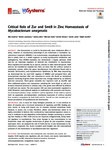Critical Role of Zur and SmtB in Zinc Homeostasis of Mycobacterium smegmatis
Goethe, Elke
Laarmann, Kristin
Lührs, Janita
Jarek, Michael
Meens, Jochen
Lewin, Astrid
Goethe, Ralph
Zinc homeostasis is crucial for bacterial cells, since imbalances affect viability.
However, in mycobacteria, knowledge of zinc metabolism is incomplete. Mycobacterium
smegmatis (MSMEG) is an environmental, nonpathogenic Mycobacterium
that is widely used as a model organism to study mycobacterial metabolism and
pathogenicity. How MSMEG maintains zinc homeostasis is largely unknown. SmtB
and Zur are important regulators of bacterial zinc metabolism. In mycobacteria,
these regulators are encoded by an operon, whereas in other bacterial species, SmtB
and Zur are encoded on separate loci. Here, we show that the smtB-zur operon is
consistently present within the genus Mycobacterium but otherwise found only in
Nocardia, Saccharothrix, and Corynebacterium diphtheriae. By RNA deep sequencing,
we determined the Zur and SmtB regulons of MSMEG and compared them with
transcriptional responses after zinc starvation or excess. We found an exceptional
genomic clustering of genes whose expression was strongly induced by zur deletion
and zinc starvation. These genes encoded zinc importers such as ZnuABC and
three additional putative zinc transporters, including the porin MspD, as well as alternative
ribosomal proteins. In contrast, only a few genes were affected by deletion
of smtB and zinc excess. The zinc exporter ZitA was most prominently regulated by
SmtB. Moreover, transcriptional analyses in combination with promoter and chromatin
immunoprecipitation assays revealed a special regulation of the smtB-zur operon
itself: an apparently zinc-independent, constitutive expression of smtB-zur resulted
from sensitive coregulation by both SmtB and Zur. Overall, our data revealed yet unknown
peculiarities of mycobacterial zinc homeostasis.
Dateien zu dieser Publikation

